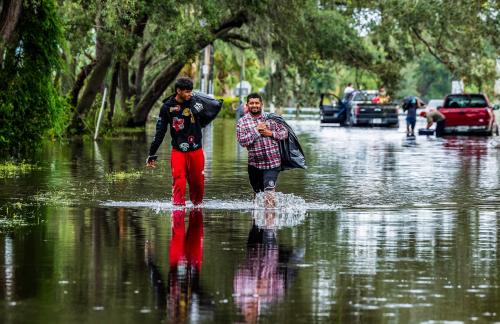In December 2021, we asked Brookings Metro’s nonresident senior fellows what the most pressing built environment issues could be in the year ahead. Their responses were remarkably prescient. Many of their warnings came true over the past 12 months, such as the need for public capacity to manage new federal funding and the dangers that could arise if cities did not step up their climate responses. Others flagged concerns that endured throughout the year, such as the need for federal fair housing enforcement and state broadband policies.
To mark another new year, we’ve decided to ask the same question again. The responses hit many of the same themes, from making housing more equitable to protecting consumer privacy. Based on last year’s track record, it’s safe to bet that many of these issues will be with us throughout 2023.
– Adie Tomer, Jenny Schuetz, and Joe Kane
Government leaders must confront the stigma around housing assistance and other public benefits
Elizabeth Linos, Nonresident Senior Fellow
The federal government’s response to the COVID-19 pandemic brought an unprecedented level of investment into the social safety net, with paradigm-shifting consequences in state and local government. For the first time in recent memory, the amount of money available is not the primary limitation—getting money into people’s pockets is. Somewhere between 20% and 50% of eligible households are not accessing benefits for which they are eligible.
The “last mile” of this challenge may also be the biggest hurdle yet: destigmatizing government assistance. The pervasive stigma—often racialized and gendered—surrounding people who access means-tested government benefits has been documented for decades. Yet we have surprisingly little evidence on how to reduce it. Emerging evidence shows that this stigma not only influences who chooses to participate in programs, but may also have long-term consequences on program design and administration, as well as how and to whom services are delivered. In 2023, I’d like to see government agencies taking a more active role in addressing the stigma associated with government benefits.
Nowhere is this more salient than in means-tested housing assistance. In a recent project in two U.S. cities, the People Lab found that reframing emergency rental assistance to reduce stigma associated with the program increased demand for applications by 40%. Increasing the supply of housing may be harder, but potentially more consequential; large programs like the Housing Choice Voucher Program depend on landlords being willing to rent to voucher holders, but we’ve found that negative perceptions about voucher holders are even more pervasive than negative perceptions of the “red tape” associated with program requirements.
Many state and local governments have undertaken herculean efforts to simplify forms, move complicated processes online, and even provide targeted assistance in accessing benefits. To equitably serve their residents, they must directly tackle stigma and stigmatization next.
Cities will still lack capacity to tackle climate change, even with the Inflation Reduction Act
Jan Whittington, Nonresident Senior Fellow
The Inflation Reduction Act (IRA) is the most important piece of climate legislation the federal government has ever passed. It includes nearly $400 billion for clean energy and related investments, as well as billions of dollars to prepare for and recover from disasters. These acts give many people hope that the U.S. will step up to stop global warming and protect communities from the impacts of climate change.
After a decade working abroad and assisting city governments in integrating climate action within their plans and budgets, I want to be more optimistic about the IRA’s potential, but I am not there yet. The issue is the scale of transformation needed to halt the rise of global temperatures while addressing climate change’s destabilizing effects. The institutions and underlying economic conditions of places and people create a vastly uneven playing field for climate action. And with the IRA, the U.S. is still sitting on the sidelines.
The built environment poses structural problems for addressing climate change that are much easier for cities to overcome if they have a stable tax base, access to financial markets, and the enabling authority to acquire the means necessary for climate action. But in the U.S., cities and other critical service providers such as energy and water utilities are not equally equipped with a robust base of taxpayers or customers. Some are thwarted by state-level or utility-specific prohibitions on mitigation, and some are already experiencing extreme losses from catastrophic events. My focus in 2023 will be on actions that promise to either level the playing field with access to tools and data that align capital investment with climate commitments or provide an early warning to those with the authority to protect communities. At the same time, it is important to examine how the financial services and insurance industries are addressing these local climate needs.
Beyond the U.S., I am also interested in the many similar challenges around cities’ capacity to take climate action, including access to data and sufficient budgets to accelerate needed investments. However, the global scale of needed climate action and investment is enormous; the United Nations estimates it at $5 trillion per year. This financial support should not stop at the doorstep of nations, withheld from its purpose of creating climate-friendly cities. There must be better ways for the international community to work together in capacity-building and enabling institutions for local climate action.
The rollout of DISH Network’s 5G wireless network will have big impacts on broadband policy
Blair Levin, Nonresident Senior Fellow
In 2023, broadband policy debates will center on how states expend tens of billions of dollars to deploy broadband networks in unserved and underserved areas, most through the Broadband Equity, Access, and Deployment (BEAD) Program. But that will not be the most consequential broadband deployment of the year. While BEAD is critical to rural areas and represents good public policy, it probably only affects 10% to 20% of the population, and the actual deployments will not occur until 2024 or later.
Rather, the most consequential construction story will involve DISH Network’s new nationwide 5G network, which Federal Communications Commission rules require be built out for 70% of the U.S. population by June 14, 2023. This network could be disruptive in at least three ways. First, as a greenfield build for a new service provider, the network could have both a cost structure advantage and incentives that offer lower prices, creating a pricing dynamic that could affect all American broadband consumers. Second, it intends to focus on wholesale offerings much more than incumbent providers, which could also be disruptive to the current market structure. Third, it is using a different network architecture—Open Radio Access Networks, which use cloud-based, virtualized, and open architecture principles—that, if it works well, could change how wireless networks are built in future generations.
If DISH’s deployment succeeds (both as a matter of construction and as a business model), it should cause the government to rethink of all kinds of policies, including those related to competition, merger reviews, spectrum management, and the general regulation of communications networks. If DISH fails, policymakers will have to rethink current policies, particularly as to whether our country should be satisfied with the current market structure and if we need to open the door to new providers.
Cities will continue to eliminate mandatory parking
Chris Severen, Nonresident Senior Fellow
Parking requirements may be the most important transportation policy that most of us don’t think about. Cities usually require new buildings to include a minimum number of parking spaces, which may seem reasonable, but typically leads to way too much parking. It’s odd that cities mandate parking while leaving the provision of housing up to market forces.
Minimum parking requirements are costly for society. First, as with any quantity regulation, they dissociate supply from demand; said more plainly, we often build more parking than we need. Second, parking takes land away from other uses, which can reduce the benefits of being near other people, intensify sprawl, and increase the costs of building. Third, because people make decisions about car ownership based on the network of places they need to access, parking minimums exaggerate the benefits of cars relative to other modes of transportation. This can turn parking minimums into an artificial subsidy for cars paid by local businesses, renters, and homeowners.
Cities are experimenting with changing the standard parking regime. Both London and Seattle removed or greatly reduced parking minimums, to the benefit of their urban environments. But other cities, such as Philadelphia, have ended temporary programs that replace on-street parking spaces with more productive uses (like streeteries). We should keep some parking, but wouldn’t it be better if the cost of parking for users reflected the cost to provide it, rather than pretending that parking is free?
New York state may finally reform its land use policies
Noah Kazis, Nonresident Senior Fellow
Arguably, no state is more in need of land use reform than New York, with its sky-high housing costs and widespread exclusionary zoning practices. The affordability crisis might be more acute in California, but Sacramento has passed law after law to loosen restrictive zoning by legalizing accessory dwelling units, duplexes, and multifamily housing along commercial corridors, and pairing that with sweeping process reforms. New York legislators can only point to a half-century of resolute inaction.
So, I’ll be watching to see whether New York finally intervenes in its localities’ restrictive and exclusionary zoning practices. In her State of the State Address this January, New York Governor Kathy Hochul put land use reform at the center of her agenda for the year. Her approach takes two tacks. First, she intends to require local governments to rezone all land around rail stations for transit-oriented development. New York has the best transit infrastructure in the country, which should support housing growth, but too many of its suburban transit stations are surrounded by single-family homes and golf courses. Most details are still forthcoming, but Hochul’s proposal appears to be roughly similar to Massachusetts’ new transit-oriented development law, which lets local governments decide how—but not whether—to provide denser, multifamily housing near transit.
Second, Hochul would set a target for new housing production in each locality: 3% growth, every three years, downstate. Places below target would face a “builders’ remedy”—mixed-income housing built regardless of local zoning—or other remedial actions. Add in an array of mechanisms for state oversight capacity, and it’s an ambitious yet realistic set of proposals—one that has learned a lot from successes and failures in other states.
But even with the governor’s forceful backing, zoning reform faces considerable political hurdles. Homeowner opposition on Long Island torpedoed a more modest set of proposals last year, while the political left has its own housing agenda that complicates matters further. But zoning reform has more momentum than ever before in New York. I’ll be watching to see whether the state takes action to make its housing system more affordable, accessible, integrated, and sustainable.
Crowdsourced consumer data could start informing planning agencies
Alex Berke, Nonresident Senior Fellow
Data collected from the public serves an important role in infrastructure planning. Traditionally, this data comes from government surveys such as the census or transportation surveys. Now, commercial entities are also collecting data from the public, at a rate superseding government collection efforts. Consider how our locations are collected every time we use mapping apps or how e-commerce websites collect information about what products people buy and where they are delivered.
While this data collection can provide useful services, much of its value to companies comes from repacking or selling it (location data from mobile phones alone is a multibillion-dollar market), which introduces privacy risks and other consumer harms. The data can also provide value to public agencies; for example, location data from mobile phones can supplement transportation surveys. Yet this also may be problematic—while people explicitly consent to share their data through surveys, that’s not the case for the commercial data generated by people simply going about their daily lives.
There is an alternative: crowdsourcing commercial data directly from consumers as a means to collect more comprehensive datasets for planning purposes, with explicit consent from those consumers. But this is only possible when people have access to the data they generate on commercial platforms, and access varies by platform. If crowdsourcing data becomes a common tool, further restricting data access might be expected from companies that profit from current data markets.
Recently, the Federal Trade Commission announced proposed rulemaking to address unfair practices in how companies retain consumer data. In our response comment, my colleagues and I argue that the agency should ensure consumers can access their own data, empowering more ownership over their digital lives. It will also enable planning agencies and researchers to crowdsource large datasets and generate knowledge that benefits the public, such as by supplementing census and survey data and providing for more informed infrastructure planning.
Regulators should begin modernizing housing codes and licensing
Anika Singh Lemar, Nonresident Senior Fellow
As a lawyer representing tenants and homeowners facing involuntary displacement as a result of evictions, foreclosures, and substandard housing conditions, nearly all of my clients live in homes that do not comply with housing codes. They are missing smoke detectors, have exterior doors that do not lock, and must deal with leaks, pests, and mold. And they have nowhere to go; even clients with tenant-side subsidies are unable to find places to move.
My clients are low-income, but I hear similar stories from middle-class and well-off students and colleagues who rent. This is not surprising: The median age of homes in my region is well over 50 years old, rental vacancy rates are extraordinarily low, and code enforcement is haphazard at best.
I have long obsessed over zoning codes’ lack of relationship to housing quality or safety. This year, I’m focused on housing codes, which are intended to protect people rather than aesthetics or property values. Historically, housing quality has been seen as an “inner-city” issue. But across the U.S., there are increases in the number of renters and people living in older housing. They live in cities, where code enforcement is politically salient, and suburbs, where it often is not. Meanwhile, we are becoming more attuned to the connections between low-quality housing, housing affordability, and residents’ health.
Housing codes regulate unit quality, and landlord licensing can—but typically does not—address whether an individual landlord has the wherewithal to manage housing. If landlords and property managers require licenses, they can be held accountable for violations across units. A landlord’s illegal retaliatory or discriminatory acts or their refusal to address code deficiencies in one building can serve as a basis to deny licensure for another building. While complicated corporate structures can frustrate licensing schemes, other areas of regulation—from liquor licensing to bank regulation—provide models from which regulators might draw lessons.
Confronting a fiscal cliff, transit agencies will have to make some hard decisions
Robert Puentes, Nonresident Senior Fellow
It is difficult to overstate the impact the COVID-19 pandemic had on public transit agencies in the United States. Not only did ridership evaporate overnight, but the recovery has been slow and uneven. According to the latest data, overall transit ridership remains about 34% lower than just before the pandemic, with rail down about 27% and bus by about 19%. For agencies that always operate on the fiscal edge, the twin challenges of less passenger fare revenue and increased costs remain daunting.
Fortunately, the Washington cavalry really did ride to the rescue by providing about $70 billion in Covid-related relief to transit agencies. That emergency aid kept buses and trains moving and served as a lifeline for essential workers and those that rely on transit to get around. But as agencies spend down that money, it is unclear how agencies will balance their budgets once the funds run out. As if on cue, S&P Global Ratings recently gave transit a negative outlook for the year.
Whether the budgetary cliff occurs in 2024 or a few years after depends on the agency. Some are more reliant on passenger fares than others, but most will still face a set of hard decisions. In 2023, those decisions come amid bold policy moves to fight climate change, address racial and social inequities, and boost a sputtering economy. Public transit is important in addressing all of them—and slashing service to cut costs is an untenable outcome.
…
The Brookings Institution is committed to quality, independence, and impact.
We are supported by a diverse array of funders. In line with our values and policies, each Brookings publication represents the sole views of its author(s).











Commentary
Around the halls: Brookings scholars discuss built environment issues that could define 2023
February 16, 2023